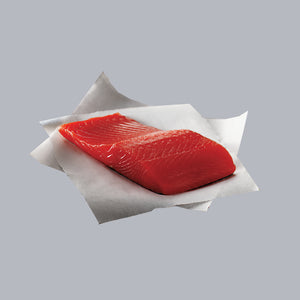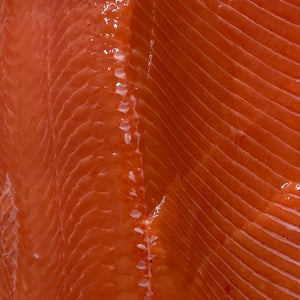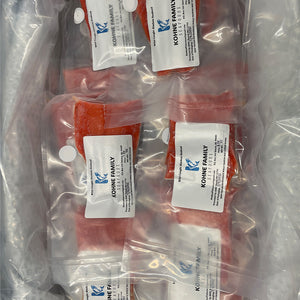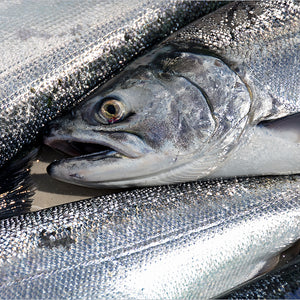Alaskan Coho Salmon
| /
Wild Alaskan Coho (also known as Silver Salmon) is a type of salmon that is native to the waters of the North Pacific, particularly around Alaska. Known for its excellent flavor and firm texture, wild Alaskan coho is a popular choice for those looking for a healthy and sustainable seafood option. Here's a deeper look into its characteristics:
1. Physical Characteristics
- Size: Coho salmon typically weigh between 6 to 12 pounds, although some can grow larger. They can reach lengths of up to 3 feet.
- Appearance: Coho salmon have a bright, silver-colored body during their ocean life, which turns a darker reddish-orange when they spawn. They are known for their streamlined bodies and sleek, shiny appearance.
2. Habitat and Lifecycle
- Habitat: Coho salmon are found in the cold, nutrient-rich waters of the North Pacific Ocean, particularly around Alaska, British Columbia, and the Pacific Northwest. They migrate from freshwater rivers to the ocean and then return to freshwater to spawn.
- Lifecycle: The typical lifecycle of coho salmon involves spending 1-2 years in the ocean before returning to their freshwater birthplace to spawn, after which they die. This is similar to other salmon species.
3. Flavor and Texture
- Flavor: Wild Alaskan coho salmon has a rich, slightly sweet flavor that is less oily than king salmon (Chinook) but still robust and satisfying.
- Texture: The flesh is firm, yet tender, making it perfect for a variety of cooking methods. It holds up well to grilling, broiling, baking, and even smoking.
4. Nutritional Benefits
- High-Quality Protein: Coho salmon is a great source of lean, high-quality protein, which is essential for muscle repair, immune function, and overall health.
- Omega-3 Fatty Acids: Coho is an excellent source of omega-3 fatty acids, which are beneficial for heart health, reducing inflammation, and promoting cognitive function.
- Vitamins and Minerals: It is rich in vitamins such as Vitamin D, B12, and A, as well as minerals like selenium, potassium, and phosphorus. These nutrients contribute to overall well-being, including bone health, energy production, and immune support.
-
3.0oz of Alaska Coho contains
- 20g Protein (40% DV)
- 4.3mcg Vitamin B12 (180% DV)
- 900mg Omega 3s DHA & EPA
- 9.6 mcg Vitamin D (48% DV)
5. Sustainability
- Wild-Caught and Sustainable: Wild Alaskan coho salmon is considered a highly sustainable seafood choice when caught from well-managed fisheries in Alaska. The Alaska Sustainable Fisheries Management practices ensure that the fishery remains healthy and that the salmon population is maintained at safe levels.
- Regulations: Fishing for wild Alaskan coho is strictly regulated by the Alaska Department of Fish and Game (ADF&G), and the state of Alaska is recognized globally for its rigorous and science-based management of salmon populations.
6. Fishing Seasons
- Coho salmon fishing typically takes place from July to November, with the peak of the fishing season occurring in late summer to early fall.
- Catch limits and harvest quotas are set to ensure the sustainability of the species, and fishery managers work closely with local communities and the fishing industry to maintain healthy salmon stocks.
7. Health Benefits
- Heart Health: Omega-3 fatty acids in coho salmon are linked to reduced risk of heart disease, improved cholesterol levels, and reduced inflammation in the body.
- Brain and Eye Health: The omega-3s, particularly DHA and EPA, play a critical role in maintaining brain function and vision health, and may help reduce the risk of cognitive decline.
- Anti-inflammatory: Coho salmon’s healthy fats help manage chronic inflammation, which is associated with a variety of conditions like arthritis, cardiovascular diseases, and certain cancers.
8. Culinary Uses
- Grilled or Broiled: Coho salmon’s firm texture makes it perfect for grilling or broiling. Simply seasoned with salt, pepper, and lemon, it's a delicious and easy way to prepare it.
- Baked or Roasted: Coho is great for baking with herbs, garlic, and butter, or roasting with a touch of olive oil for a crispy skin.
- Smoked: Coho salmon is often smoked to create flavorful dishes like smoked salmon spread, or can be served on a bagel with cream cheese and capers.
- Salads and Sushi: Coho is also a great option for use in salads, bowls, or even raw as sushi or sashimi.
9. Availability and Price
- Wild Alaskan coho is typically available fresh or frozen, and prices can vary depending on the time of year, availability, and whether it is wild-caught or farmed. Because it’s a wild-caught fish, coho tends to be more expensive than farmed varieties, but it is considered to have superior flavor and sustainability.
10. Sustainability Certifications
- Look for labels like the Marine Stewardship Council (MSC) or Sustainable Fisheries certification, which indicate that the fish was caught following sustainable practices that ensure the protection of the species and the environment.
In summary, wild Alaskan coho salmon is a delicious, nutritious, and sustainable fish choice. Its mild flavor, firm texture, and health benefits make it a versatile addition to any diet, and its wild-caught nature from well-regulated fisheries ensures that it is an environmentally responsible option. Whether grilled, baked, or smoked, it’s a tasty way to enjoy the best of what the Alaskan waters have to offer.







